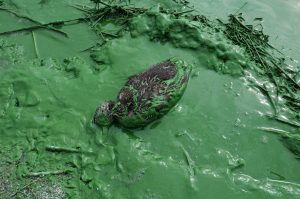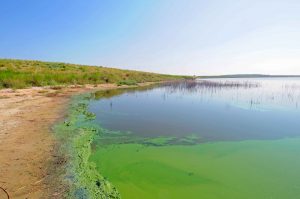Bird mortality event associated with microcystins at Poplar Island, Maryland, USA
 More than 750 dead and dying birds were observed at the Paul S. Sarbanes Ecosystem Restoration Project at Poplar Island, Maryland, USA (Chesapeake Bay) in summer 2012. Avian botulism was suspected based on clinical signs. At the same time, a bloom of Microcystis was also ongoing in an impoundment on the island, and high levels of microcystins were detected.
More than 750 dead and dying birds were observed at the Paul S. Sarbanes Ecosystem Restoration Project at Poplar Island, Maryland, USA (Chesapeake Bay) in summer 2012. Avian botulism was suspected based on clinical signs. At the same time, a bloom of Microcystis was also ongoing in an impoundment on the island, and high levels of microcystins were detected.
Samples of the water, algal material and the livers from two mallards (Anas platyrhynchos) were collected and analysed by several analytical methods such as the commercial ADDA-ELISA, the multihapten-ELISA, LC-UV/MS and LC-MS2 and the results are shown in Table 1.
Table 1. Microcystin concentrations (± standard deviations) in the originally analyzed water (ng/mL), the lyophilized water sample (µg/g dry weight), and mallard tissue (ng/g dry weight) samples as measured by different techniques.
| Technique | Analyte | Water (ng/mL) | Lyophilized Bloom (µg/g) | Mallard #1 (ng/g) | Mallard #2 (ng/g) |
| Adda ELISA | Total Free MCs | 6000 ± 850 | 340 ± 30 | 72 ± 14 | 64 ± 13 |
| Hapten ELISA | Total Free MCs | NA | 510 ± 50 | 124 ± 9 | 113 ± 7 |
| Hapten ELISA | Total MCs | NA | 430 ± 20 | 272 ± 7 | 256 ± 14 |
| MMPB (LC-MS2) | Total MCs | NA | 840 ± 50 | 218 ± 8 | 172 ± 4 |
| LC-UV-MS/(MS) | MC-LR | 150UV | NA | < 4.5 | < 4.5 |
| LC-UV-MS/(MS) | [Leu1]-MC-LR | 3800UV | NA | 67 ± 9 | 25 ± 3 |
Microcystin-LR was detected in the water, together with an unknown microcystin. NMR spectroscopy, LC-HRMS and LC-MS2 on purified material of the unknown compound confirmed the analogue to be [D-Leu1]MC-LR.
Lyophilized algal material from the bloom was further characterized, and an additional 24 microcystin variants were detected.
 The mallard livers were tested to confirm microcystin exposure, by both measuring free and bound microcystins. The bound microcystins were released by thiol de-conjugation and MMPB (3-methoxy-2-methyl-4-phenylbutyric acid) techniques to give an estimation of “total” microcystins.
The mallard livers were tested to confirm microcystin exposure, by both measuring free and bound microcystins. The bound microcystins were released by thiol de-conjugation and MMPB (3-methoxy-2-methyl-4-phenylbutyric acid) techniques to give an estimation of “total” microcystins.
The levels of microcystin varied based on the analytical method used, highlighting the need to develop a comprehensive analysis strategy to elucidate the etiology of bird mortality events when microcystin-producing HABs are present. This work illustrates that microcystin levels are highly dependent on the technique used, and care must be taken to choose an appropriate method for analysis.
Read more here.